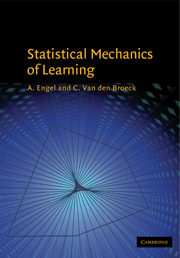Book contents
- Frontmatter
- Contents
- Preface
- 1 Getting Started
- 2 Perceptron Learning – Basics
- 3 A Choice of Learning Rules
- 4 Augmented Statistical Mechanics Formulation
- 5 Noisy Teachers
- 6 The Storage Problem
- 7 Discontinuous Learning
- 8 Unsupervised Learning
- 9 On-line Learning
- 10 Making Contact with Statistics
- 11 A Bird's Eye View: Multifractals
- 12 Multilayer Networks
- 13 On-line Learning in Multilayer Networks
- 14 What Else?
- Appendices
- Bibliography
- Index
11 - A Bird's Eye View: Multifractals
Published online by Cambridge University Press: 05 June 2012
- Frontmatter
- Contents
- Preface
- 1 Getting Started
- 2 Perceptron Learning – Basics
- 3 A Choice of Learning Rules
- 4 Augmented Statistical Mechanics Formulation
- 5 Noisy Teachers
- 6 The Storage Problem
- 7 Discontinuous Learning
- 8 Unsupervised Learning
- 9 On-line Learning
- 10 Making Contact with Statistics
- 11 A Bird's Eye View: Multifractals
- 12 Multilayer Networks
- 13 On-line Learning in Multilayer Networks
- 14 What Else?
- Appendices
- Bibliography
- Index
Summary
For a fixed set of input examples, one can decompose the N-sphere into cells each consisting of all the perceptron coupling vectors J giving rise to the same classification of those examples. Several aspects of perceptron learning discussed in the preceding chapters are related to the geometric properties of this decomposition, which turns out to have random multifractal properties. Our outline of the mathematical techniques related to the multifractal method will of course be short and ad rem; see [172, 173] for a more detailed introduction. But this alternative description provides a deeper and unified view of the different learning properties of the perceptron. It highlights some of the more subtle aspects of the thermodynamic limit and its role in the statistical mechanics analysis of perceptron learning. In this way we finish our discussion of the perceptron with an encompassing multifractal description, preparing the way for the application of this approach to the analysis of multilayer networks.
The shattered coupling space
Consider a set of p = αN examples ξµ generated independently at random from the uniform distribution on the N-sphere. Each hyperplane perpendicular to one of these inputs cuts the coupling space of a spherical perceptron, which is the very same N-sphere, into two half-spheres according to the two possible classifications of the example.
- Type
- Chapter
- Information
- Statistical Mechanics of Learning , pp. 193 - 208Publisher: Cambridge University PressPrint publication year: 2001



